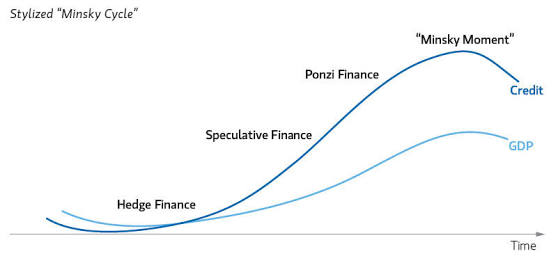Economists are always made fun of when it comes to their models as and their predictions well their success rate is as good of Indian meteorological department for that of monsoon in Mumbai overall it’s accurate but fails to predict next two days rains.
But what if I tell you that there’s a way to predict a financial crisis.
There is a concept of business cycle born out of observations that business have a period of growth when indirectly the economy grows followed by recession when businesses start failing causing a slowdown in economy. This can happen over few years or even decades but due to its periodic nature many economies have learnt to protect themselves.
Now to the main point you see in the business cycle there is a special type called a bubble, it is a highly dangerous concept where a good or service’s prices expand exponentially with ever increasing demand which is beyond rationale. This happens because people have a craze about something and market is not able to keep up the supply this leads to increase in prices. The bubble expands as more capital is injected to increase supply. The time when the bubble bursts this the Minsky moment the exact time when a bubble bursts causing a loss of billions if not trillions to the world economy
Why does this happen? And where was has this concept developed from?
To answer these questions especially the second one we will have to dive into history. It is post great depression the governments running on keynesian principles have step in to push the economy upwards. A person named Ddr. Hyman Minsky a former mathematician, now an economist wrote a theory that explained the previous and many of the future crisiscrises. This was called the “Financial -– Instability” hypothesis according to the the theory it is the stability of the market which forces crises i.e. Stability leads to instability, the boom of today sows seeds of financial discord of tomorrow( The Economist :Minsky’s moment).
He says there are three types of people who invest and take loans and credit they are the Hedge funds, the speculative investors and finally the ponzi investors, each of them has a separate attribute.
The hedge fund starts in the initial stages where companies use their profit to not only grow but also have the ability of repaying any debt with interest they the most stable as they have no problems in gaining any extra debt from financial institutes and banks. Then are the speculative over here the stability starts getting deteriorated they take loans on the assumed value of assets. They can mostly just pay the interest amount but never return the principle. They have to constantly refinance and re-borrow to sustain their growth, most of the companies never proceed from this stage. The third and the most unstable are ponzi e.g. Lehman Brothers they borrow high and rarely are able to pay even the interest this leads to accumulation of debt which after a short time leads to bankruptcy, also as the value of asset is negligible or it is so less that the banks cannot recover their dues. When several such investors go bankrupt, the banks also goes into crises thereby cutting of any source of funds for the hedge funds.
Minsky moment is the tipping point when the debt to asset ratio causes the ponzi’s to shut their shop.
This was the reason why this happens and for the second it existed during the 70’s while the term was coined by Paul Mcculley in 1998 to describe the 1998 Russian financial crisis. The mainstream economists obsession about models and the fact that Minsky of his own questioned the financial aspects of the central banks was sufficient to push him to the extremes.
Current Situation
The Minsky Moment became famous after the subprime mortgage crisis of 2007-10. This crisis happened because the governments had removed regulations that prevented shadow banks to invest in such assets that were ponzi in nature and also that banks indiscriminately gave their money to anyone without seeing the asset’s value.
The crisis happened because the so called housing boom collapsed pulling itself the banks and other financial institutes which had to be bailed out by government which caused an economic collapse second to only the great depression. This lead to new regulations and the dodd-frank act in USA and implementation of Basel III and similar regulations
Sources under Wikipedia: Minsky’s Moment,Financial crisis of 2007-2008
The economist : Financial Stability: Minsky’s Moment
By Aviraj Singh Mehta




